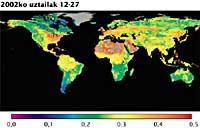Anton Uriarte: "Earth is the planet of human beings and it makes no sense not to want to perceive human influence"
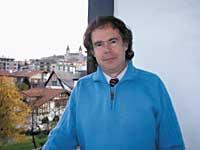
Those of the Russian Academy of Sciences do not think that warming is a problem, but are believed to be good. However, when drafting the Protocol, Europeans have made a small trap: They were based on 1990 data. And at that time they emitted many greenhouse gases. Russia emitted 40% more than now, leaving CO 2 emission permits. You can sell them, but not who bought it. In the United States it had placed its hope, but they have not ratified the Protocol.
The complexity of the Protocol is evident.What complicates the protocol is, for example, the possible exchange of gas emissions. Six greenhouse gases, carbon dioxide (CO 2 -a), methane, nitrous oxide, perfluorocarbons, hydrofluorocarbons and sulfur hexafluoride are considered. However, to facilitate calculations the equivalent emission of carbon dioxide is used as a unit and to calculate the equivalences of the other gases it has been agreed that the value of the global warming capacity of CO 2 is one. The equivalences have been calculated according to the calorific power of each gas within 100 years, depending on the time spent in the atmosphere and the duration of carbon dioxide. Thus, 21 grams of CO 2 and a gram of methane are equivalent to the time of exchange.
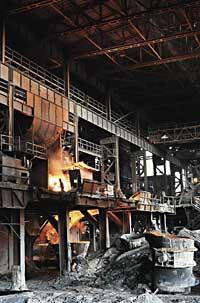
However, we still do not know for sure what is the difference between carbon dioxide and other gases, for example, when it comes to the absorption of infrared radiation, and this depends on the heating produced by each gas.
And according to the Protocol, all this can be adapted, so they hold so many meetings. In this way confusion is generated and some can take advantage of this situation and deceive...
With the new year a kind of CO 2 emission bag has been launched, a market selling and buying CO 2 emission permits.This issue is also very confusing and appears quite diffuse in the Protocol. In fact, it aims to reduce emissions. Companies that issue less CO 2 than allowed offer the possibility to sell the surplus permits to which they issue more than they deserve. But there are many other factors that are also taken into account.
Projects are studied and approved individually and a large bureaucracy is required. For example, in Tokyo there is an immense electric company that will have to reduce its emissions, but it will not have to reduce what is believed, among other things because it will contribute to the development of nuclear energy, promote renewable energies, improve the efficiency of thermal power plants... all this has allowed to emit more than it deserves. But, in addition, he will plant eucalyptus trees in a South American village because they act as sinks of CO 2 and help to collect the methane that transports the purine in the pig farms of the Chilean company Agrosuper so that it does not move to the air. In fact, methane has a great calorific power, and if they avoid the emission of a ton of methane into the atmosphere in Chile, they will be able to emit 20 tons of CO 2 more at the Tokyo power plant.
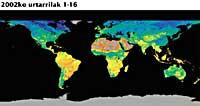
I, to tell the truth, do not know. The two forms of measurement used are in contradiction with the results. One of the measurement forms is surface thermometers, the conventional thermometers found in weather stations around the world. These thermometers are only followed by two centers and presumably work well. Depending on these surface thermometers there has been a slight warming, although the average monthly global temperature in the last 15 years is not clear. Of course, there is a clear drop of more than half a degree after the eruption of the Pinatubo volcano in June 1991, and the rise that El Niño suffered between 1997 and 1998.
Another way of measuring is by satellite, measuring the radiations emitted by atmospheric oxygen, as they depend on temperature. The graphs of these measurements and surface graphs present similar temperature variations, but hardly show temperature increases. These measurements are made by NASA and, curiously, prefer to show the others, which are those received on the surface.
Surface measurements have a problem that has not yet been fully resolved: the urban effect. Some of the thermometers previously found in the countryside are now, as towns and cities grow, in the urban center. And, as is known, in the cities there is a kind of heat island that raises the temperature. In all this there are still many doubts, and it is not true that all scientists agree, as is often said.
However, according to climate models, warming would not be affected by compliance with the Protocol.They only show a difference equal to or less than a tenth grade if they meet the Proto or not.
According to some, the Protocol is for awareness. Some will do business with grants and methane will become CO 2... I think all this is mostly too complex.
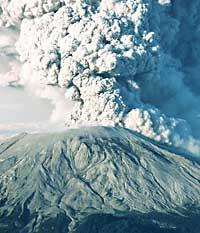
Many factors are taken into account, but only those we can measure. And one of those factors is CO 2, which can be quantified by infrared radiation. But, for example, clouds have much more importance and are not taken into account because we do not know how to measure them. It seems that the low clouds cool because they reflect the sun and the high and fine clouds, the cirros, warm up. But they don't know.
And even more complex factors are marine currents. This makes experts ensure that the Gulf stream can be slowed by the Arctic effect. And these factors have already begun to be measured.
What climate models predict and what happens in reality are often contradictory.Given that climate models have increased greenhouse gases, in Antarctica it should be much hotter. But Antarctica has cooled down and so does NASA. According to the models, the temperature should be increased in large latitudes, that is, in the Arctic and in Antarctica. Therefore, there is a contradiction.
Another error of the models is that they announced that the troposphere should be warmed more than the terrestrial surface, but surface thermometers and satellite measurements show just the opposite.
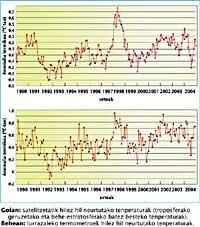
However, CO 2 itself does not predict significant warming: Doubling CO 2 would increase the temperature by 1.2 degrees in a hundred years.
Can we know what effects humans have on global warming?There is the other problem, because you cannot know. And that is ultimately the basic debate. The amount of CO 2 in the atmosphere can be known about what has increased, and I think it has increased by human action. The Earth is the planet of human beings and it makes no sense not to want to perceive human influence.
And the controversy lies in what part of the warming is due and not to CO 2 in case of warming. Keep in mind that some places were warmed up before adding CO 2, from 1850, when there was hardly any industry. For example, the glaciers of the Alps began to retreat around 1850, after a brief glacial period of the 18th century. In the 20th century.
There are other contradictions, such as the greater penetration of CO 2 after World War II, with the greatest industrial development, while the temperature decreased between 1940 and 1970 according to surface thermometers. Some attribute it to aerosols, central sulfide clouds, and other refrigerant substances.
Suppose, however, that the Earth is really warming, how will we prevent it?The main strategy is to prevent the CO 2 of the large power plants from coming out into the air: collecting it, transforming it into liquid and storing it somewhere. But this is not possible in cars, and burning gasoline also generates CO 2.

And don't believe, we also create CO 2 by breathing. Each person generates each day the same as a car at 5 km. The Kyoto Protocol establishes a 5% reduction in emissions from 1990 emissions, which is less than what humanity generates only by inhalation.
The problem is that the Protocol is based on what will happen within a hundred years. But someone knows what the Earth will be like within a hundred years, what energy systems will be used... What happens is that what the models advertise for 50 years is nothing spectacular. If the current warming speed is maintained, the Earth will heat around one degree. And that doesn't frighten anyone. However, forecasts to a hundred years indicate that it will heat between 1.2 and 5 degrees on average, about 3 degrees.
I believe that change would be beneficial for humanity, for vegetation... A few years ago National Geographic published a report on this subject and complained that in some places in Alaska there were flooded forests. It seems to me a nonsense!
Buletina
Bidali zure helbide elektronikoa eta jaso asteroko buletina zure sarrera-ontzian




